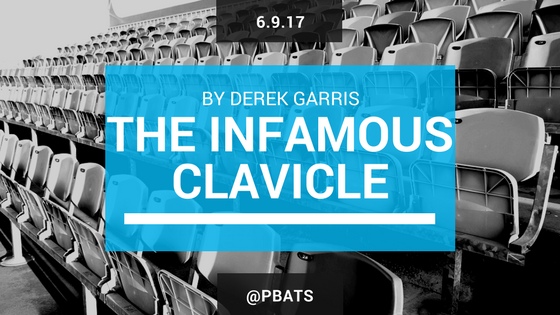Written by Derek Garris, PT, DPT, EMR / Chicago White Sox
Overview
Our normal definition to explain scapulohumeral rhythm (SHR) is for every two degrees of glenohumeral (GH) motion there is one degree of scapular motion during elevation. Interpreting this definition, it is easy to forget about the importance of the clavicular joints during shoulder elevation. Moving forward in this commentary lets briefly review how the clavicle contributes to shoulder elevation, any potential negative impacts of hypomobility of the clavicular joints on the shoulder, assessment, and treatment approaches.
Clavicular Contribution to Elevation
The clavicle is the only bone that connects the upper extremity to the axial spine. It also moves in three degrees of freedom when articulating with the sternum and acromion. When moving freely, the clavicle accounts for approximately 30 degrees of rotational motion during shoulder elevation. As the arm begins to elevate the first 30-60 degrees of motion happens at the GH joint only. At this point the sternoclavicular (SC), acromioclavicular (AC), and scapulothoracic (ST) joints begin to move and aid in achieving full 180 degrees of elevation. These concomitant movements of these three joints along with the GH joint naturally provide for functional overhead activity.
Potential Negative Impacts
Now let’s ask ourselves this question: What could happen if there is a limitation at the clavicular joints? A limitation here may lead to subsequent limitation in GH motion and consequently disrupt the line of pull from the rotator cuff and other ST muscles. Sequentially, this has the potential to lead to muscle weaknesses, various GH joint pathology, scapular dyskinesia, and other chronic shoulder conditions too many to describe in this passage. Therefore, the clavicular joints become a major component to assess during evaluation of a throwing athlete.
Assessment
To start this section, lets pose another question to think about critically. How can one say that the limitation is coming from the GH joint without assessing the clavicle? Theoretically, one can’t say it’s not the clavicular joints if you have not assessed them. Gathering a better understanding on whether or not the range of motion limitation is coming from the clavicular or GH joints will assist you in developing a treatment plan. Hopefully this will avoid the “kitchen sink approach” and help in treating the true impairments.
Treatment and Prevention
Theoretically, let’s say the athlete has a clavicular dysfunction. From an immediate treatment stand point, the clinician must ensure the clavicle has adequate joint mobility through the use of various manual techniques. In conjunction with joint restoration the clinician must incorporate exercises to maintain mobility and begin to initiate normal scapulohumeral motor control and coordination. In combination with these exercises shoulder strengthening, endurance, proprioceptive, postural training, plyometric exercises, and return to sports activities should be implemented based off the athlete’s impairment list. Finally, and probably most important are the preventative strategies the clinician decides to implement and should be part of the treatment strategy. Depending on the chronicity of the condition the clinician must decide on primary, secondary, or tertiary prevention interventions in addition to the rehabilitative efforts. Singularly, a routine check of clavicular joint mobility can be a preventative measure alongside may others. Insuring adequate mobility may help reduce stress on a players’ shoulder. Thus reducing risk for injury or in some situations re-injury. Remember specificity to a players’ condition is always best practice.
Conclusions
As an athletic trainer or physical therapist, it is important to understand all the possibilities that may contribute when assessing a player with or without a shoulder injury. Consideration of all possibilities helps us focus on the global picture and focuses us to act preventively rather than fixating on a single region of the extremity. Secondly, we should make it a habit to assess the clavicular joints and treat them if impairments are found to avoid missed steps in the rehabilitation process. To conclude, we cannot assume that the clavicular joints have normal movements based on visual assessment alone. Is mispresentation of the clavicle contributing to a variety of injuries in throwing athletes? The only way to know is to ask ourselves if we have been assessing everything, even “the infamous clavicle.”

